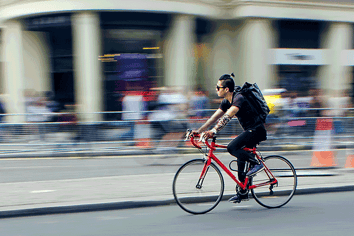
How many times does an employee come in late to work, blaming the traffic? Chances are good that it’s a valid excuse. While the DFW Metroplex has creeped its way down the “worst commutes in North America list,” it still has challenges when it comes to commuting. A growth in population, compounded with never-ending roadway construction, makes delays the norm, not the exception.
In fact, the 2015 Urban Mobility Scorecard released by Texas A&M University’s Transportation Institute in August 2015 found that in 2014 DFW ranked #7 in terms of travel delays, with the average DFW driver wasting 53 hours sitting in traffic.
The commuting stress is real. What does this mean to you? Some employees will arrive chronically late and stressed out. It can take them, on average, 25 minutes to get focused, which means your talent is not working to capacity or potential.
On the other hand, some employees arrive on time, focused and ready to rock their day. What is their secret? Instead of a superpower that makes them able to avoid traffic, they probably just manage their commutes better. Here are six habits of employees who manage their commute time well.
-
They Leave Home Early. Yes, this seems like an obvious one, but planning for the unexpected should be, well, expected. Most people underestimate the amount of time it will take to drive to work. Use this formula to calculate rush-hour commute time:
normal travel time x 1.27 = travel time during rush hour
Here is also a handy chart that estimates average commute times throughout the DFW metroplex.
-
They Use a Traffic Map App. Almost everyone has a smartphone. Smart commuters check the traffic maps before leaving for work. Not only does it help them avoid accidents and congestion, it gives them an approximate arrival time and alternate routes.
-
They Avoid the Rush. Sometimes even a 15- or 30-minute shift in the time they leave home or the office can mean the difference between traveling with the pack or smooth sailing. If the workplace allows flex-time, even a modest shift can help employees arrive timely not tardy.
-
They Skip the Morning Email. Many people check email prior to leaving the house for work. While in theory this helps people prepare for their day, in reality they are likely to get distracted by checking Instagram or Facebook and being even later to work. Face it, if it's really urgent, they'll probably get a text or a phone call, too.
-
They Adjust Their Attitude. Smart commuters use commute time to get themselves mentally prepared by the day. Whether it's rocking out to heavy metal, getting the morning news from NPR, or listening to a Serial podcast, they do something that pleasantly engages their brain and gets them focused and relaxed on something besides the horrible traffic or their to-do list.
-
They Let Someone Else Do the Driving. Commuters who use public transit like rail, bus or rideshare avoid the stress of driving altogether and use their commute time for more productive—or relaxing—ends. There’s also something satisfying about gliding past all the cars on a jammed freeway and arriving on schedule. Even taking a break from driving just once or twice a week takes the pressure off.
 You might think that as cities get larger and more crowded, it bodes disaster for any commuter ever getting to work on time. Fortunately, transportation planners and businesses are already working together to reshape the urban landscape and solve the transportation challenges of the future. The good news for employers is that millennials—now the largest generation in the American workforce—are leading the way.
You might think that as cities get larger and more crowded, it bodes disaster for any commuter ever getting to work on time. Fortunately, transportation planners and businesses are already working together to reshape the urban landscape and solve the transportation challenges of the future. The good news for employers is that millennials—now the largest generation in the American workforce—are leading the way.
According to a 2013 study by the American Public Transportation Association “The largest generation in U.S. history and the most multi-modal could be a game changer for public transportation and America’s transportation network as a whole.” Driven by economic necessity, convenience, a focus on healthy living and an inclination toward a social lifestyle, millennials are increasingly embracing a multimodal lifestyle. Companies will need to adapt to the different ways that millennials work, live and commute, which will ultimately drive welcome changes to the rush-hour commute to work.
Download our infographic to share commuting tips (and send a hint to the repeat stragglers).

